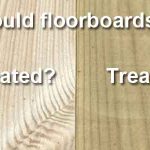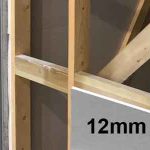Whilst it is possible to use standard plasterboard in a bathroom (and many people do), it is certainly not the best product. A normal plasterboard is not designed to deal with high levels of moisture, and over longer periods it can deteriorate.
If you are tiling the boards, then grout and any silicone around the edges will stop moisture reaching the board. However, if the grout fails, water will be able to enter and soak into the boards.

Also, if the wall or ceiling is being skimmed and painted, a moisture resistant bathroom paint can be used, as extra protection. However, you still have the same problem. If the paint and plaster fail, moisture will be able to enter the plasterboard below it. Once this happens, the plasterboards will soak up water. Over time, this can cause the board to deteriorate.
When plasterboard gets wet over a prolonged period, several things can happen:
- The inside of the board can swell and lose structural integrity. This can also lead to the boards bowing and losing their flat surface.
- Paper can de-laminate from the boards. This can be a big problem for tiles, as the weight can cause the wet plasterboard paper to tear away from the plaster core.
- Finally, mould can occur. If left untreated, this can spread and cause damage to other areas. It will also produce spores that can be harmful when breathed in. Also, an unpleasant smell is quite common.
If you already have standard plasterboard in your bathroom, it is not the end of the world. Providing it isn’t subject to prolonged moisture exposure, it should be fine. However, you should ensure that missing grout is replaced and any other defects, such as peeling paint are fixed ASAP.
What plasterboards should be used in a bathroom?
The ideal solution is a moisture resistant plasterboard. This product is similar to a standard plasterboard in its appearance and workability. The most obvious difference is the colour, as this type of board tends to be green.
The other major difference is the material it is made of. Moisture resistant boards still have a solid gypsum core. However, it has additional silicone additives, which make the plasterboard water resistant.
Due to this extra additive, the boards are far more suitable in high moisture areas. This means they will not suffer the same deterioration issues of standard plasterboards.
With that said, it is important to point out that moisture boards are moisture resistant, not waterproof. They can not be submerged in water. Also, extremely high levels of moisture, over prolonged periods, could cause them to fail. However, they will be far more effective than a standard board.
When tiling, you should tile straight onto the board (no need to plaster). Before you do this, you should apply an acrylic primer to the plasterboard, and use a good quality waterproof grout.
If you intend to skim the boards, you will need to take some extra steps. Moisture resistant plasterboard is not ideal for plastering. Due to the moisture resistant additives, the plaster will struggle to get a good key, as there is little suction in the board.
The solution to this, is using a bonding agent prior to skimming. This will create a suitable key for the plaster.
Another alternative to plasterboard in a bathroom
Whilst moisture resistant plasterboard will be sufficient in most cases, there are other products that are even more resistant to moisture when tiling in areas such as showers and around baths.
The most common product is tile backer boards. These are a cement-based product that are extremely durable and 100% waterproof. Due to this it can be used in the wettest areas without any risk of deterioration.
The one issue with backer board is the price. Generally, a moisture resistant plasterboard is around double the price of a standard board. For backerboards, you can double this price again (at least).
Therefore, it is not the cheapest solution, but it is the best. A good compromise would be plaster boarding the majority of your bathroom in moisture boards. Then you can use a backer board in the areas requiring the most water protection. For example, shower areas, and around the bath.
Conclusion
Normal plasterboards can be used in the vast majority of situations. Its good for walls and ceilings throughout a property. However, it is not designed to withstand high levels of moisture.
This means, for areas like bathrooms and even kitchens, a moisture resistant plasterboard is usually your best choice. It is more expensive, but it will avoid future repairs and replacement, for a much longer time.
In certain areas, where moisture will be very high and you want to tile, cement-based backer boards will offer the added protection you need.




